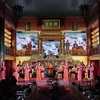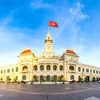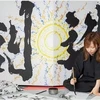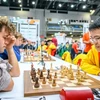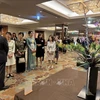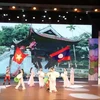Artists and fine-arts lovers celebrate the birth of Nguyen Phan Chanh (1892-1984) in Hanoi on July 20.
"Chanh is considered one of Vietnam 's foremost silk artists," said Tran Khanh Chuong, Chairman of the Vietnam Fine Arts Association. "He worked prolifically during the war era, but never depicted battle scenes. His art celebrated peace, beauty and the daily lives of people, especially rural people."
Chanh's daughter, writer Nguyen Nguyet Tu agreed. "He once said he didn't bring war into his paintings because ‘guns could shoot through silk'.
"He painted children, young women, farmers and workers with a love for life and plenty of optimism," she said.
Chanh, among the first students of the Indochina College of Fine Arts, now Hanoi University of Fine Arts, was one of the greatest Vietnamese painters of the last century, creating his own style and techniques for painting on silk.
Before he started work, Chanh washed the silk canvas in warm water. When the first layer of colours dried, he washed the painting again before adding new colours until he was satisfied with the work.
In 1928, he became the first Vietnamese painter to have a painting reproduced on a postage stamp in France . It was titled Nguoi Di Cay (Transplanters in the Field).
After winning a prize for his work in Paris in 1931, he built a career as a lecturer of fine arts.
In 1996, he was posthumously awarded the Ho Chi Minh Prize, the noblest award for literary and fine-art work in Vietnam .
Chanh left about 170 silk paintings and 52 sketches when he died, according to his family. Most of them are stored in museums and private collections throughout the world. His family owns a small number.
His work has been displayed in France , Italy , the US , Japan , the former Czechoslovakia , Hungary , Romania , Poland and the former Soviet Union .
In 1932, paintings such as O An Quan (Children Playing Games), Rua Rau Cau Ao (Washing Vegetables by a Pond), Len Dong (Mediumship) and Em Be Cho Chim An (Children Feeding Birds) were the first Vietnamese paintings introduced to a French audience in Illustrations magazine.
However, as time goes by, the fragile paintings have been damaged, some seriously. Japanese specialists who love his work volunteered to restore them. The first three restorations were enjoyed by 36,000 visitors to an exhibition in Japan last year.
Japanese specialists are now working on another five silk paintings. They will showcase the restored works and borrow others from private collectors to organise an exhibition of Chanh's paintings in Japan next October.
Paris Fine Arts Museum and private collectors who own Chanh's paintings will organise an exhibition commemorating him in Paris in September.-VNA
"Chanh is considered one of Vietnam 's foremost silk artists," said Tran Khanh Chuong, Chairman of the Vietnam Fine Arts Association. "He worked prolifically during the war era, but never depicted battle scenes. His art celebrated peace, beauty and the daily lives of people, especially rural people."
Chanh's daughter, writer Nguyen Nguyet Tu agreed. "He once said he didn't bring war into his paintings because ‘guns could shoot through silk'.
"He painted children, young women, farmers and workers with a love for life and plenty of optimism," she said.
Chanh, among the first students of the Indochina College of Fine Arts, now Hanoi University of Fine Arts, was one of the greatest Vietnamese painters of the last century, creating his own style and techniques for painting on silk.
Before he started work, Chanh washed the silk canvas in warm water. When the first layer of colours dried, he washed the painting again before adding new colours until he was satisfied with the work.
In 1928, he became the first Vietnamese painter to have a painting reproduced on a postage stamp in France . It was titled Nguoi Di Cay (Transplanters in the Field).
After winning a prize for his work in Paris in 1931, he built a career as a lecturer of fine arts.
In 1996, he was posthumously awarded the Ho Chi Minh Prize, the noblest award for literary and fine-art work in Vietnam .
Chanh left about 170 silk paintings and 52 sketches when he died, according to his family. Most of them are stored in museums and private collections throughout the world. His family owns a small number.
His work has been displayed in France , Italy , the US , Japan , the former Czechoslovakia , Hungary , Romania , Poland and the former Soviet Union .
In 1932, paintings such as O An Quan (Children Playing Games), Rua Rau Cau Ao (Washing Vegetables by a Pond), Len Dong (Mediumship) and Em Be Cho Chim An (Children Feeding Birds) were the first Vietnamese paintings introduced to a French audience in Illustrations magazine.
However, as time goes by, the fragile paintings have been damaged, some seriously. Japanese specialists who love his work volunteered to restore them. The first three restorations were enjoyed by 36,000 visitors to an exhibition in Japan last year.
Japanese specialists are now working on another five silk paintings. They will showcase the restored works and borrow others from private collectors to organise an exhibition of Chanh's paintings in Japan next October.
Paris Fine Arts Museum and private collectors who own Chanh's paintings will organise an exhibition commemorating him in Paris in September.-VNA

